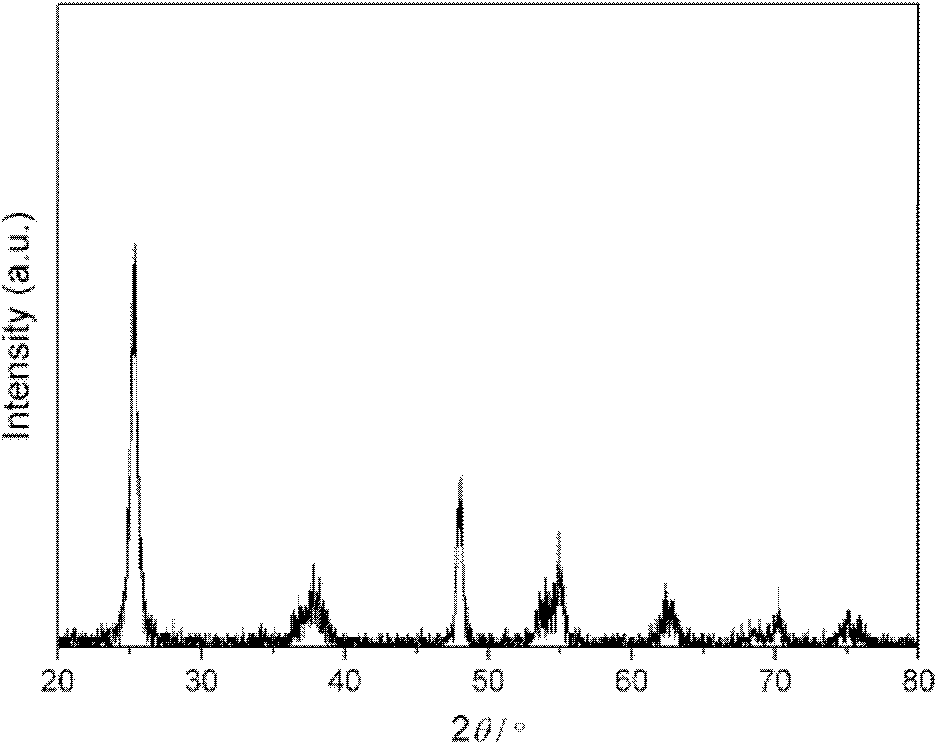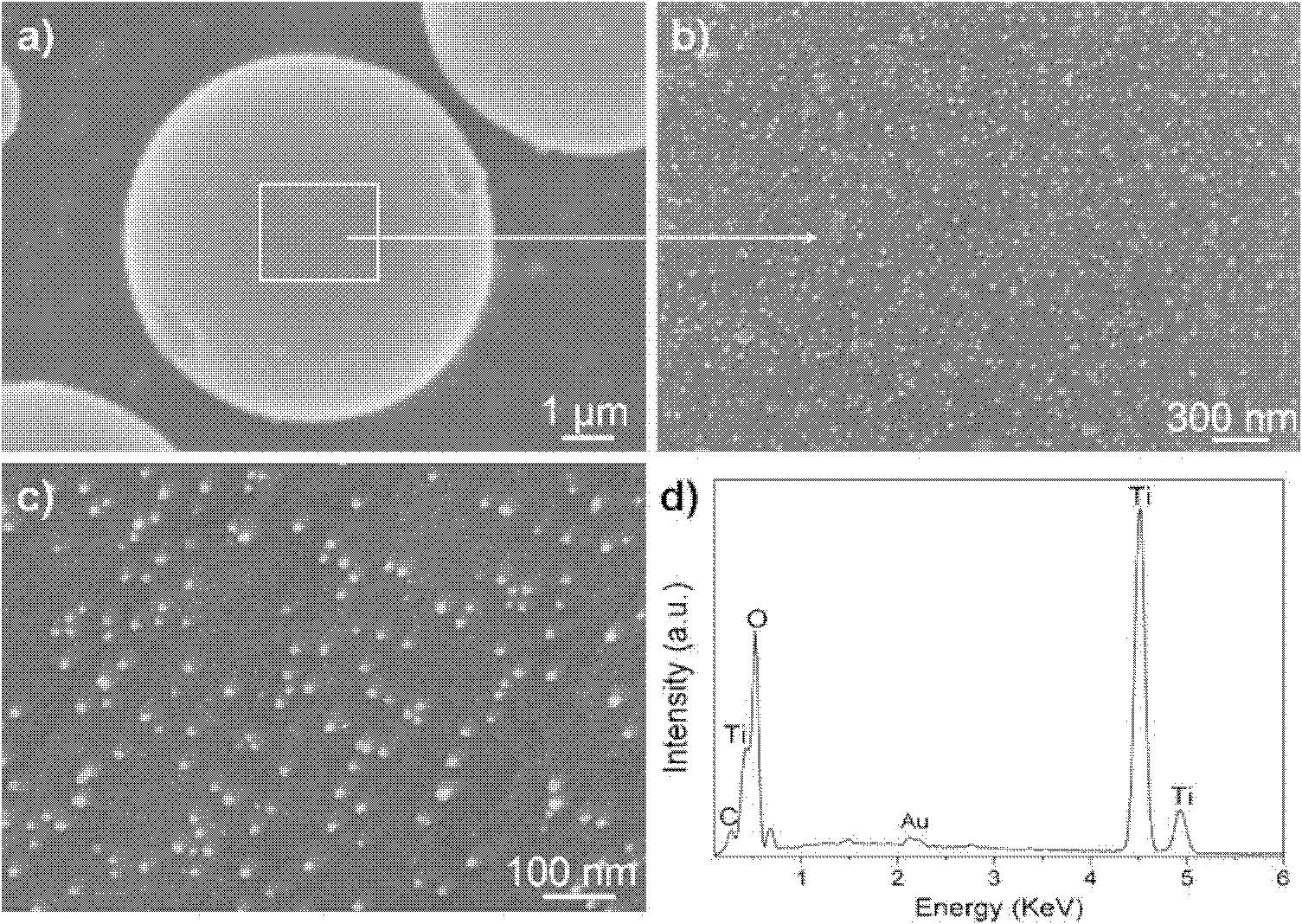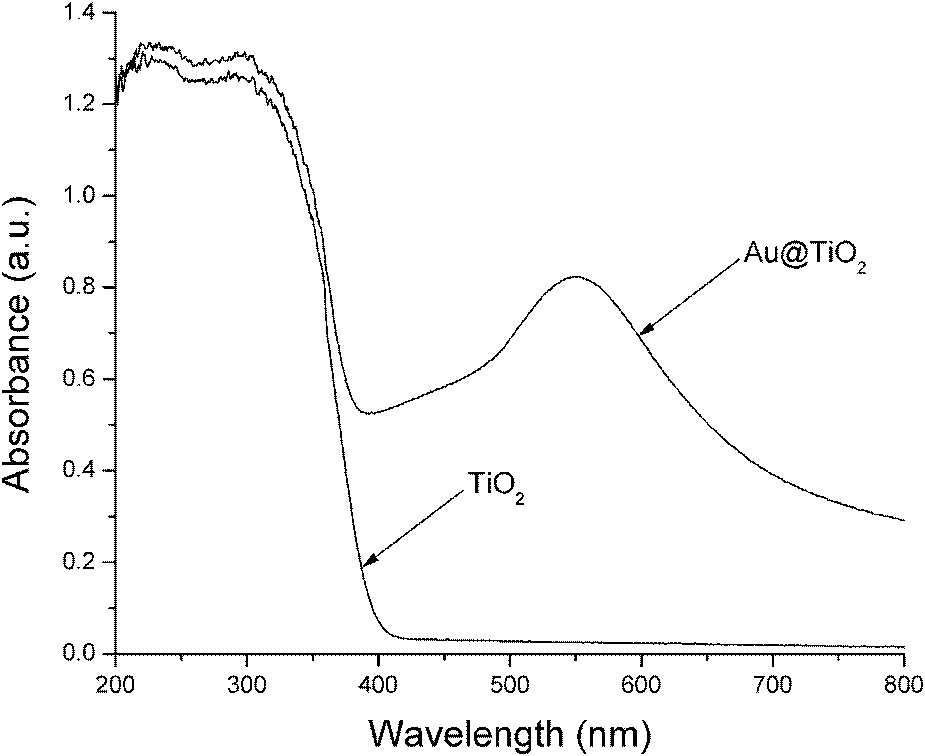Method for preparing titanium dioxide-supported noble metal visible light material
A photocatalytic material, titanium dioxide technology, applied in the direction of metal/metal oxide/metal hydroxide catalysts, chemical instruments and methods, physical/chemical process catalysts, etc., can solve problems such as difficult to control the uniform distribution of noble metal nanoparticles, and achieve The effect of highly efficient selective photooxidation reaction
- Summary
- Abstract
- Description
- Claims
- Application Information
AI Technical Summary
Problems solved by technology
Method used
Image
Examples
Embodiment 1
[0021] In this example, titanium dioxide microspheres were selected as the carrier. Mix tetrabutyl titanate and ethanol uniformly at a volume ratio of 1:4, and add 40% hydrofluoric acid solution: wherein the volume ratio of tetrabutyl titanate and hydrofluoric acid solution is 25:3. Put the mixed solution into an autoclave lined with polytetrafluoroethylene, and react at 180°C for 2 hours. After natural cooling, the product is washed, filtered, and dried to obtain anatase phase titanium dioxide with a diameter of 3-6 μm. Microspheres.
[0022] Add 1g of titanium dioxide microspheres into 50mL of absolute ethanol to form a suspension, feed nitrogen, and irradiate with ultraviolet light for 3min under anaerobic conditions, and then inject 1wt% of chloroauric acid into the suspension in the dark. 3+ Under the reduction of the metal ions, the metal ions are converted into elemental metal nanoparticles and deposited on the surface of titanium dioxide, thus forming AuTiO 2 Visible...
Embodiment 2
[0025] In this example, titanium dioxide microspheres were selected as the carrier. Mix tetrabutyl titanate and ethanol uniformly at a volume ratio of 1:5, and add 40% hydrofluoric acid solution: wherein the volume ratio of tetrabutyl titanate to hydrofluoric acid solution is 25:3. Put the mixed solution into an autoclave lined with polytetrafluoroethylene, and react at 160°C for 2 hours. After natural cooling, the product is washed, filtered, and dried to obtain anatase phase titanium dioxide with a diameter of 3-5 μm. Microspheres.
[0026] Add 0.5g of titanium dioxide microspheres into 50mL to form a suspension, feed nitrogen, and irradiate with ultraviolet light for 10min under anaerobic conditions, then inject a certain amount of (1wt%) chloroplatinic acid into the suspension in the dark. Ti 3+ Under the reduction of the metal ions, the metal ions are converted into elemental metal nanoparticles and deposited on the surface of titanium dioxide, thus forming PtTiO 2 Vis...
Embodiment 3
[0028] In this example, titanium dioxide microspheres were selected as the carrier. Mix tetrabutyl titanate and ethanol uniformly at a volume ratio of 1:4, and add 40% hydrofluoric acid solution: wherein the volume ratio of tetrabutyl titanate and hydrofluoric acid solution is 25:3. Put the mixed solution into an autoclave lined with polytetrafluoroethylene, and react at 170°C for 2 hours. After natural cooling, the product is washed, filtered, and dried to obtain anatase phase titanium dioxide with a diameter of 3-6 μm. Microspheres.
[0029] Add 0.5g of titanium dioxide microspheres to 50mL of absolute ethanol to form a suspension, feed nitrogen, and irradiate with ultraviolet light for 5min under anaerobic conditions, then inject a certain amount (1wt%) of silver nitrate into the suspension in the dark , at Ti 3+ Under the reduction of the metal ions, the metal ions are converted into elemental metal nanoparticles and deposited on the surface of titanium dioxide, thus for...
PUM
| Property | Measurement | Unit |
|---|---|---|
| Diameter | aaaaa | aaaaa |
| Diameter | aaaaa | aaaaa |
Abstract
Description
Claims
Application Information
 Login to View More
Login to View More - R&D Engineer
- R&D Manager
- IP Professional
- Industry Leading Data Capabilities
- Powerful AI technology
- Patent DNA Extraction
Browse by: Latest US Patents, China's latest patents, Technical Efficacy Thesaurus, Application Domain, Technology Topic, Popular Technical Reports.
© 2024 PatSnap. All rights reserved.Legal|Privacy policy|Modern Slavery Act Transparency Statement|Sitemap|About US| Contact US: help@patsnap.com










